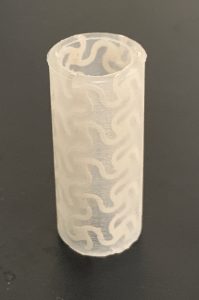
New composite-based, 3D-printed artery can monitor blockages from the inside
Canadian Plastics
3D Printing Research & DevelopmentThe implantable vessel was developed by engineers from University of Wisconsin–Madison in collaboration with Zhejiang University in China.

The implantable, 3D-printed artificial blood vessel is made of a flexible composite and capable of real-time monitoring. Photo courtesy of Xudong Wang
Replacing part of a blood vessel – in order to treat blood clots, coronary disease, stroke damage and more – is a difficult operation for surgeons but it’s only part of the process: monitoring the grafted vessel after surgery is the other part, and this is done by CT scans, ultrasounds, and other expensive imaging techniques.
Despite all that effort, between 40 to 50 per cent of those grafts fail – which is why materials science engineers from University of Wisconsin–Madison, in Madison, Wis., have developed a new, 3D-printed artificial blood vessel that allows doctors and patients to keep tabs on its health remotely.
The implantable vessel is made from a flexible polymer composite and capable of real-time monitoring. “This artificial vessel can produce electric pulses based on pressure fluctuation which will be able to tell precisely the blood pressure in the vessel without using any additional power source,” said team leader and UW–Madison professor Xudong Wang. “And because of the 3D geometry, the electric pulse profile will be able to tell if there is an irregular motion due to blockage inside in the very early stages.”
To develop the vessel, the research team – which includes collaborators from UW–Madison’s School of Medicine and Public Health and Zhejiang University in China – combined sodium potassium niobite piezoceramic nanoparticles with a polyvinylidene fluoride polymer which is ferroelectric, or able to flip polarity when an electric field is applied. They then printed a tubular artery using the material and an off-the-shelf 3D printer. The printer extrudes the material through a strong electric field close to the nozzle to polarize the ceramic particles, giving the structure its piezoelectric property.
The researchers’ next step is to optimize the production of the new ferroelectric composite and the 3D printing process. The team also wants to find ways to make the printed 3D structure even more sensitive, and plans to collaborate with researchers in the biomedical field to test the artery with even more realistic models of the circulatory system.
Additionally, they hope to use the new material to print artificial heart valves. Replacement heart valves are typically either mechanical or taken from human or animal donors, and none incorporate the type of self-monitoring found in the research team’s material. “This is an easy, scalable technology,” Xudong Wang said. “Our new printable composite material allows us to make a 3D structure in one step that can show multi-functionality right out of manufacture.”
Source: University of Wisconsin–Madison
